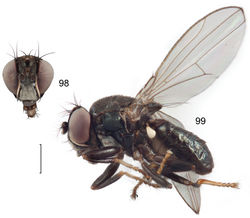Lamproclasiopa argentipicta
| Notice: | This page is derived from the original publication listed below, whose author(s) should always be credited. Further contributors may edit and improve the content of this page and, consequently, need to be credited as well (see page history). Any assessment of factual correctness requires a careful review of the original article as well as of subsequent contributions.
If you are uncertain whether your planned contribution is correct or not, we suggest that you use the associated discussion page instead of editing the page directly. This page should be cited as follows (rationale):
Citation formats to copy and paste
BibTeX: @article{Costa2016ZooKeys, RIS/ Endnote: TY - JOUR Wikipedia/ Citizendium: <ref name="Costa2016ZooKeys">{{Citation See also the citation download page at the journal. |
Ordo: Diptera
Familia: Ephydridae
Genus: Lamproclasiopa
Name
Lamproclasiopa argentipicta Costa & Mathis & Marinoni, 2016 sp. n. – Wikispecies link – ZooBank link – Pensoft Profile
Diagnosis
This species is distinguished from congeners by the following combination of characters: Moderately small to medium-sized shore flies, body length 2.90–3.20 mm. Head: Frons with two longitudinal, grayish microtomentose stripes; fronto-orbits and narrow, medial triangular area shiny black. Antenna blackish brown. Face with light silver microtomentum, except for shiny black lateral margins; parafacials white, microtomentose. Gena moderately high, gena-to-eye ratio 0.16–0.22. Thorax: Mesonotum shiny black, covered with brownish microtomentum; presutural supra-alar seta lacking or indistinguishable from surrounding setae; pleural region less microtomentose, anepisternum and katepisternum almost bare, concolorous with mesofrons. Wing hyaline, lacking any pattern or markings. Costal vein ratio 0.45–0.50; M vein ratio 0.57. Forecoxae light gray, mid and hind coxae blackish brown; forefemur with 4–5 stout, peg-like setae on apical third along posteroventral margin; femora and tibiae blackish brown, except for distalmost part of tibiae, yellowish; tarsi yellow. Abdomen: Generally shiny blackish brown, sparsely microtomentose; tergites 5 larger than previous tergites. Male terminalia (Figs 100–103): Epandrium in posterior view (Fig. 100) with dorsal 2/3 quadrate, as wide as high, corners rounded, ventral third as 2 thumb-like projections, dorsal portion thickly developed, as wide or wider than width of lateral structure, setulae evenly distributed dorsally and laterally, becoming very sparse ventrally, ventral extensions bearing tiny setulae in verticomedial alignment, apically with cluster of small setulae, in lateral view (Fig. 101) as 2 right angles, dorsal portion more robust, thick, then a right anterior angle, then a ventral right angle to form digitiform extension that bears closely set setulae along anterior margin; cerci in posterior view (Fig. 102) elongate, moderately thin, generally shallowly arched, slightly ventrally than dorsally, dorsal angle with vertex narrowly rounded, ventral apex acutely pointed, in lateral view elongate, narrow, ventral portion tapered; aedeagus in lateral view (Fig. 103) as an irregular funnel, tapered from thick base to pointed apex, narrowed more abruptly on apical 1/8 then narrowly pointed at right angle, in ventral view (Fig. 102) generally clavate, gradually becoming wider from truncate base toward apex, widest subapically, thereafter abruptly narrowed to slender, digitiform apex; phallapodeme in lateral view (Fig. 103) narrowly triangular with vertex toward aedeagal base elongate and narrow, keel narrow, subequal to process extended toward hypandrium, in ventral view (Fig. 102) narrow, elongate with a sub-basal cross-piece and narrow, lateral extensions, thereafter almost parallel sided; gonite in lateral view irregularly rod-like, in ventral view (Fig. 102) wider than high and with a mediobasal, short, digitiform projection; hypandrium in lateral view (Fig. 103) thin, elongate, rod-like, shallowly curved, slightly wider anteriorly than posteriorly, in ventral view (Fig. 102) robustly U-shaped with thickened base, broadly rounded anterior margin and deeply U-shaped posterior emargination.
Type material
The holotype male of Lamproclasiopa argentipicta is labeled “COSTA RICA. Prov. San José. Moravia. Zurquí de Moravia, Tower path. 1600m. 9–16 AGO 2013. Proyeto ZADBI. Malaise trap #1, 0m, ZADBI-1018. -84:00:57 10:02:58 #107537/INB0004433874 INBIOCRI COSTA RICA [plastic bar code label]/HOLOTYPE ♂ Lamproclasiopa argentipicta Costa, Mathis & Marinoni MNCR-A [red].” The holotype is double mounted (glued to a paper triangle) and is in very good condition, and is deposited in MNCR-A. Three paratypes (1♂, 2♀; MNCR-A, USNM) bear the same label data as the holotype.
Type locality
Costa Rica. San José. Zurquí de Moravia (10°2.8'N, 84°0.6'W; 1588 m).
Distribution
(Fig. 104), Neotropical: Costa Rica (San José).
Etymology
The species epithet, argentipicta, is of Latin derivation and means painted with silver, referring to the silver microtomentose areas of this species, especially its face.
Remarks
This species is apparently closely related to Lamproclasiopa hendeli, based on external features, such as the shiny black body and the face that is covered with silver gray microtomentum. The male terminalia, however, are unique within Lamproclasiopa, with two setulose projections ventrally and with the ventral projection of the phallapodeme being very thin, appearing to be almost fused with the hypandrium.
Original Description
- Costa, D; Mathis, W; Marinoni, L; 2016: A revision of the shore-fly genus Lamproclasiopa Hendel (Diptera, Ephydridae) ZooKeys, (631): 1-99. doi
Images
|

![Figures 100–103. Lamproclasiopa argentipicta sp. n., male paratype (Costa Rica. San José: Moravia) 100 epandrium and cerci, posterior view 101 same, lateral view 102 internal structures of male terminalia (aedeagus [shaded], phallapodeme, gonite, hypandrium), ventral view 103 same, lateral view. Scale bar = 0.1 mm.](https://species-id.net/o/thumb.php?f=Zookeys-631-e10718-g035.jpg&width=220)
